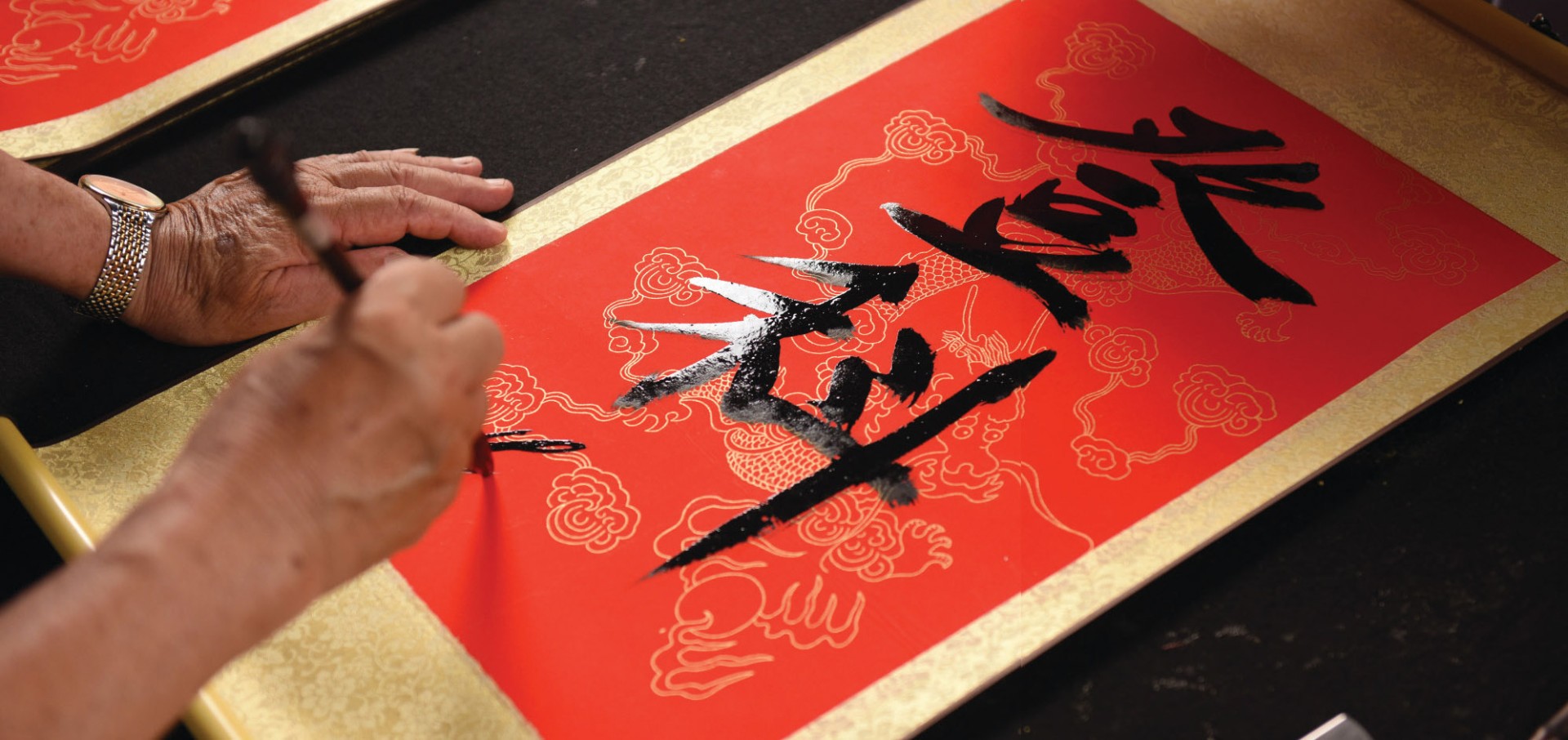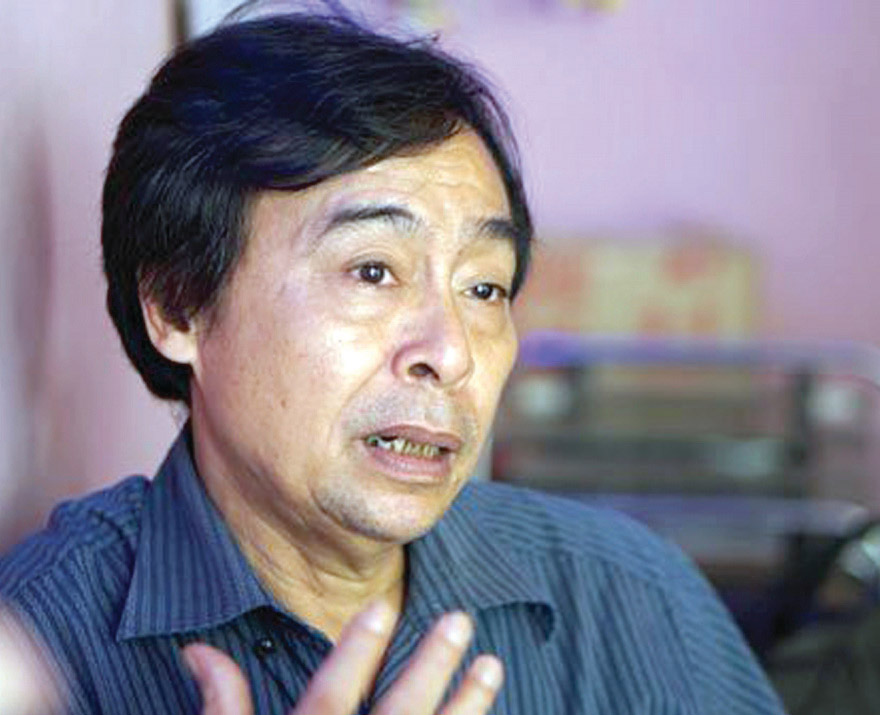In late 1995 and early 1996, 27 years ago, I was assigned to write a documentary script for the 40th anniversary of the Faculty of Literature. In the introduction to the Han Nom major, I wanted to have a scene of Han Nom students practicing Chinese calligraphy. I immediately asked the teachers in the department, absolutely no one knew how to hold a brush pen. What should I do?
At that time, in Hanoi, there were only a few people who liked to write calligraphy. Mr. Hong Thanh wrote and sold calligraphy at 62-64 Ba Trieu Street, near the wall of Kim Dong Publishing House, and it was bustling with customers. Mr. Le Xuan Hoa often wrote at the Temple of Literature - Quoc Tu Giam every spring. Mr. Nguyen Van Bach wrote calligraphy at home, his calligraphy was precious and rare, only people who knew him could get it. Playwright Tao Mat often wrote on the steps of the Army Literature Magazine, he often beat bamboo branches to make a brush to imitate the "phi bach" strokes. Painter Le Quoc Viet, who was proficient in both calligraphy and Chinese calligraphy, wrote for fun as gifts for friends and created paintings.
Researcher Nguyen Hung Vi
After going around to find out, I went to the office of Principal Phung Huu Phu. He is a talented person, an artist and a very good practical manager. Listening to my presentation on calligraphy and professional training for students majoring in Han Nom, he thought and said:
- Great! Unique move! The school just received the 3rd floor, building C4, Me Tri dormitory, and planned to reserve it all for the Military faculty, but I'll give you a room at the end, do whatever you want with it. Are you done yet?
I was so happy that I went to get the room key and made a plan to establish a Calligraphy Club. Paper was taken from under my desk, the piles of university entrance exam papers that had accumulated over the years. If I didn’t have enough paper, I went to Mr. Dinh Gia Duc’s house to ask for some old newspapers that he had brought back from the department. Pens and ink were bought in the old town to use as capital to learn how to write. There was a Han Nom 40-41 major for students and anyone who was interested could join. Just go to that room, pick up a pen and draw whatever you wanted.
The largest number of members at the time included Nguyen Van Thang, Nguyen Duc Dung, Nguyen Van Thanh, Tran Trong Duong, Pham Van Tuan, Nguyen To Ly, Quach Thu Hien, Nguyen Van Thuc, To Lan, Phung Minh Hieu... They were students majoring in Han Nom from K40 to K45.
It was difficult to invite a teacher. I went to the Institute of Han Nom Studies to ask. Luckily, when I got there, I saw Nguyen Xuan Dien busy practicing writing, his pen as small as a chopstick, his handwriting slanted but even. I asked for two lines of Du Fu's poem that I loved very much:
Spring water boat like heavenly seat
The old man came to see the flowers and the clouds in the middle of the river.
(When I was young, I was able to go on a boat trip and it was as good as traveling on clouds.
Now that I'm old, looking at flowers is like looking at fog.
I suggested Xuan Dien to guide the next class. Dien laughed loudly:
- How can I teach, teacher? I've only studied for 3 months.
I invited Mr. Le Xuan Hoa to teach me the first strokes, but after a few sessions I ran out of money. Luckily, Nguyen Van Thanh had studied with his grandfather since he was a child, so his "leg" was already strong, and he had been carefully trained to teach each other.
Artist Le Quoc Viet travels and guides more than anyone else. Le Quoc Viet's strength is that he is an artist, so he can handle space very delicately. Not every calligrapher who stands in front of a piece of paper has that artistic eye.
Having just drawn the letters, we organized an exhibition in the school, in the department. And more daringly, or someone incited us, we organized an exhibition at the Temple of Literature - Quoc Tu Giam. I remember that time most, after the letters were hung, Professor Kieu Thu Hoach pulled my shirt to the hanging pictures:
- Vi, look, this is an exhibition. The word has hunched shoulders, here. The word has a shrunken neck, here too. The word has a crooked spine, right? The word has a limp, here. This word is crooked, no different from "the beggar Cau".
I was embarrassed but I had already hung it up. Deaf people are not afraid of guns, so the opening ceremony continued as usual.
Then gradually become wiser, each person chooses a style that they like to practice: Chan, Trien, Hanh, Cao... Whatever.
The movement began to spread to many universities such as the University of Education, the Diplomatic Academy, the Foreign Trade University, the University of Culture, etc., creating a large calligraphy movement. And from then on, the streets around the Temple of Literature gradually became increasingly crowded calligraphy streets throughout the Spring month.
One time, I had just come home from the Spring Festival when the phone rang:
- You come here and judge. They are arguing.
I turned around and saw the whole group sitting at the bar. The situation was very tense. It turned out that they were debating two “schools” of calligraphy: “lim mo” and “abstract”. The Foreign Trade and Pedagogy students followed the “lam mo” school, and did not create anything. The Humanities students followed the “abstract” school, arguing that if they continued to “lim mo”, they would not be able to follow others for the rest of their lives, and they had to develop their own school.
I broke up the party and suggested that whoever wanted to follow whatever they wanted, as long as it was beautiful.
I called my friends in the Han Nom field and suggested writing Nom calligraphy because, in Vietnamese, the majority is of Chinese origin as Mr. Hoang Xuan Han once said. Nom is similar although the structure of the phonetic recording is clearer. So, for a Nom passage, the Han calligraphy community will look at the image and feel the meaning. For example, the sentence: "Lac dac tau tieu may mot mua" will be understood completely through the artistic presentation of the characters.
The club turned to abstract calligraphy and began organizing compositions.
The first task was for the group to divide up the translation of English, Chinese, and French documents on contemporary art to exchange expertise. After that, they focused on creating.
Half a month later, I received a call to go to the other side of the river, where Le Quoc Viet rented a place to “approve” the work. I brought my son along to take pictures. When I got there, oh my god! There was paper and…alcohol. The brothers were shirtless, with shorts in this corner and that. More than 100 strange calligraphy works were displayed everywhere. Whether they were beautiful or not was not yet known, but very strange.
The story goes that the painting was not enough space to dry on the porch, so they spread it out in the yard. The next morning, the calligraphy looked very strange. It had multi-layered color stains overlapping each other, but it was completely different from the multi-color ink used in Japanese calligraphy. The layers of color were freer, more random, and much more handmade. From that suggestion, the brothers used a natural biological substance to create a strange and unique mid-tone (this has not been announced yet because it is a professional secret).
In a flash, that Tien Van calligraphy became known abroad. To emboss the calligraphy, the domestic technique was not enough, so they had to go all the way to Guangxi to emboss each piece by hand. They kept it a secret, so they fought today and picked it up tomorrow, working all night. But only two days later, some calligraphers from Beijing came to find them. When asked, they learned that they had received a call from the workshop owner here to inform them that there was a group of Hanoi calligraphers with very strange works, and they wanted to come and exchange.
From there, Tien Ve calligraphy met an engineer, appraiser and broker, signed a contract to create and trade works. Viet calligraphy exhibited in many different countries.
Lately, things seem to have calmed down about calligraphy among students. To mark the 50th anniversary of the department, we have asked successful calligraphers to come back and teach the next generation an art form that fits well with this educational goal. |
|
Author: Nguyen Hung Vi
Source: VNU Newsletter 372



